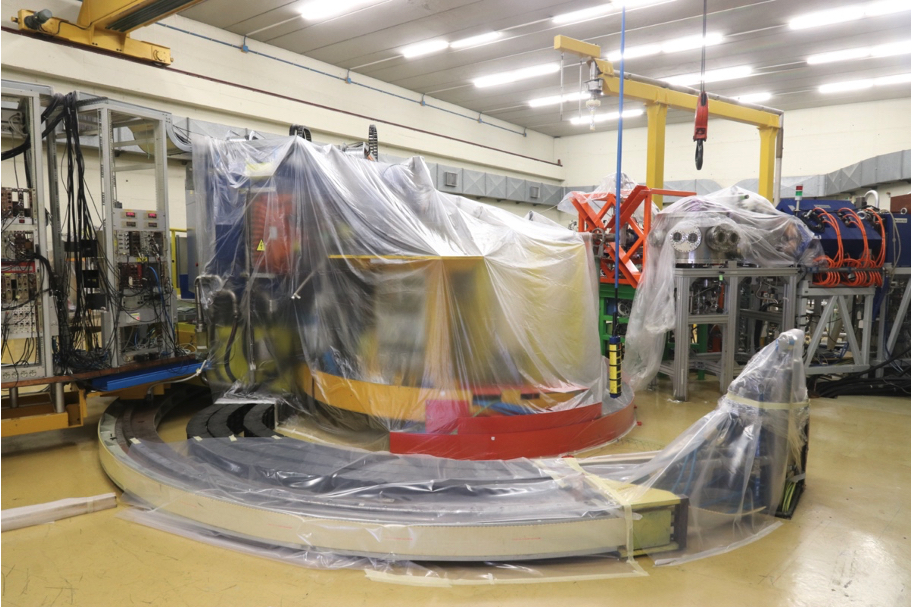Past news
Toward a solution to the missing lithium problem
Toward a solution to the missing lithium problem
If there is something missing that should be there, what is the cause? ― It has been known for decades that there is a significant discrepancy between the theoretical and observed lithium abundance in the early universe; the primordial 7Li abundance is overestimated and/or underobserved by a factor of 3 – 4. Such an inconsistency is called the “cosmological lithium problem (CLP)”, although the standard Big Bang theory is known as a very “successful” model in comparison with most of other observational facts.
Researchers now found experimental evidence that the theoretical 7Li abundance should be corrected downward by about 10%. This is not yet a complete solution, but a necessary contribution for the further theoretical approaches to the CLP solution with slightly less dauting tasks.
The first lithium is created during the Big Bang nucleosynthesis (BBN) period as well as hydrogen and helium from a jumble of protons and neutrons. The BBN is a complex network of nuclear reactions, and the abundance of a nuclide depends not only on the reaction directly to produce it but also on the reaction to destroy it and often on other reactions along the way. For example, the abundance of 7Li is mainly dominated by the production and reduction processes of 7Be. This falls in the context of the primordial nucleosynthesis studied performed by the ASFIN group and in particular to the investigations on 7Be destruction which has been examined in several papers.
Project Assistant Professor Seiya Hayakawa from the Center for Nuclear Study – the University of Tokyo collaborating with the nuclear astrophysics group ASFIN of the INFN – LNS, Sungkyunkwan University, and others leads an experimental project aiming at measuring the nuclear reactions responsible for the 7Be reduction in BBN. Recently, there are several attempts to measure these reactions 7Be(n, p)7Li and 7Be(n, α)4He by other research groups, but the data in the BBN-relevant energy region were still somewhat scarce.
These reactions are very difficult to observe directly since both 7Be and neutron are unstable. The research group proposed to use deuteron as a target instead of a bare neutron, and a 7Be beam produced by the CRIB (Center-for-Nuclear-Study Radioactive Ion Beam separator, https://www.cns.s.u-tokyo.ac.jp/crib/crib-new/home-en/index.html). This is a unique technique known as the Trojan Horse method, developed by the nuclear astrophysics group at INFN – LNS. By this method, the deuteron is like the Trojan horse in Greek myth, and the neutron is the soldier who sneaks into the impregnable city of Troy, namely, the reactions of interest, 7Be(n, p)7Li and 7Be(n, α)4He. The experimental result shows a significant contribution of the transition to the first excited state of 7Li for the first time, which offers a further 7Be reduction during the BBN and ultimately less 7Li abundance by about 10%.
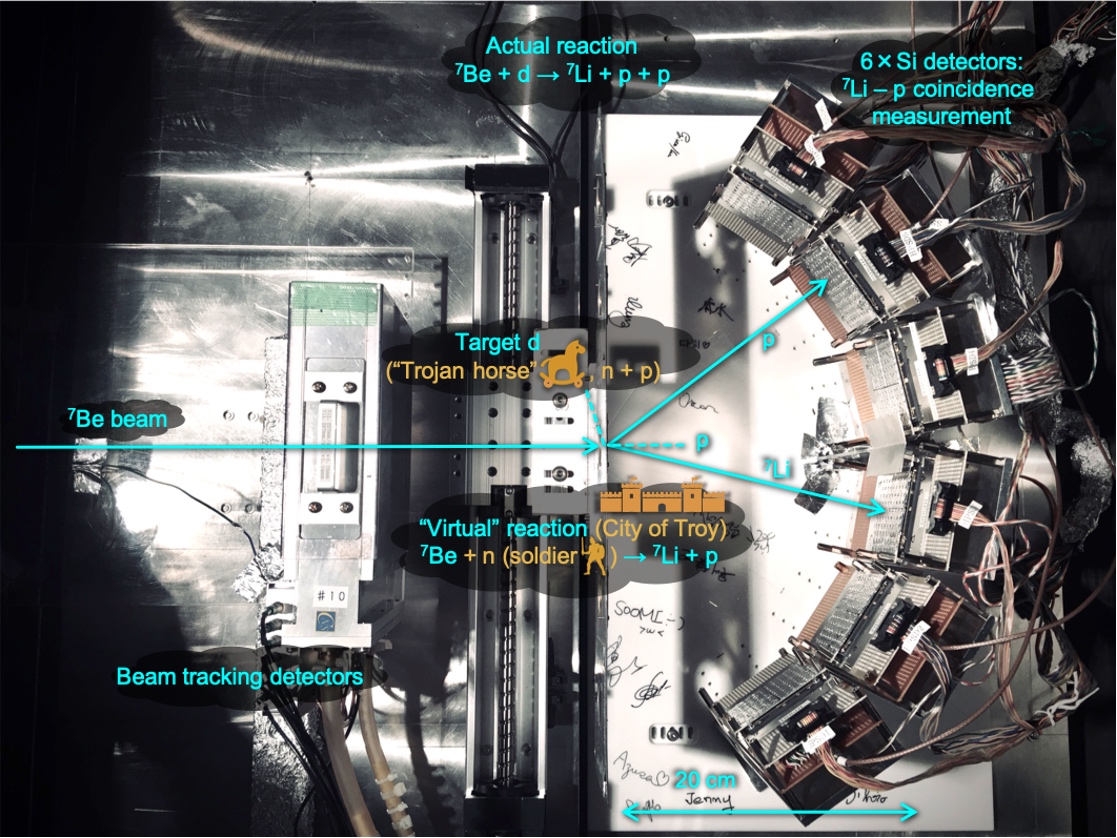
Experimental setup and conceptual diagram of the Trojan Horse method
Link to the original paper: https://iopscience.iop.org/article/10.3847/2041-8213/ac061f
Press release of The University of Tokyo (in Japanese): https://www.s.u-tokyo.ac.jp/ja/info/7456/
Press release of The University of Tokyo (in English): https://www.u-tokyo.ac.jp/focus/en/press/z0508_00184.html
For more details:
Seiya Hayakawa
Center for Nuclear Study, The University of Tokyo
Email: This email address is being protected from spambots. You need JavaScript enabled to view it.
Marco La Cognata
INFN – LNS
Email: This email address is being protected from spambots. You need JavaScript enabled to view it.
A new analysis of nuclear reactions raises questions about the evolution of the oldest stars
A new analysis of nuclear reactions raises questions about the evolution of the oldest stars
The oldest stars, which date back more than 13 billion years, show surprisingly high calcium abundances. Among the various models suggested by astrophysicists to explain this curious behaviour, one of the most accredited is based on the fact that these old stars originated from material coming from a generation of primeval massive stars, formed shortly after the big bang. These primeval stars would end their existence in a faint-supernova process and would produce elements up to the calcium region. To do this, the primeval stars should burn hydrogen into calcium through a series of so-called breakout reactions.
Among all these reactions, those involving a proton and a fluorine-19 nucleus represent a critical turning point on the path toward calcium: if the reaction leads to the emission of a gamma ray and a neon-20 nucleus, the nucleosynthesis process goes on, while if it leads to the production of an alpha particle and an oxygen-16 nucleus, the process takes a backward step.
Given the particularly delicate role of these nuclear reactions, a group of American, Canadian, and Italian researchers collected and analysed, through refined quantum models of nuclear reactions, the experimental data that have been accumulating in the literature for over seventy years on collisions between protons and fluorine-19 nuclei. In this way, new estimates have been obtained on the rates of these nuclear reactions in stars and on their uncertainties, which have been used to perform complex calculations of stellar nucleosynthesis. The obtained calcium abundance is much lower than that observed experimentally, despite the considerable uncertainties due to the poor knowledge of the nuclear structure of some states in neon-20. This new tension between theoretical predictions and experimental observations on calcium in the oldest stars casts doubts on the consistency of faint supernova processes and draws attention to the need to obtain new data on low-energy p+19F nuclear reactions.
Because of the impact of the results obtained on one of the most debated astrophysical scenarios today, the work was reported as Editors' Suggestions of the Physical Review C journal and was the subject of a synopsis in the prestigious magazine Physics of the American Physical Society.
On the Italian side, Ivano Lombardo, researcher of the INFN Section of Catania, contributed to this research work. In the past years he has carried out various low energy measurements at the INFN Laboratori Nazionali di Legnaro and at the Tandem accelerator of Federico II University of Naples on the p + 19F nuclear reaction channels with the emission of an alpha particle and an oxygen-16 nucleus.
For more information on this research topic, the reader is referred to the original article:
R. J. deBoer, O. Clarkson, A. J. Couture, J. Görres, F. Herwig, I. Lombardo, P. Scholz and M. Wiescher, 19F(p, γ)20Ne and 19F(p,α)16O reaction rates and their effect on calcium production in Population III stars from hot CNO breakout, PHYSICAL REVIEW C 103, 055815 (2021)
and to the synopsis in Physics:
M. Schirber, Uncertainty over First Stars, May 26, 2021 • Physics 14, s66
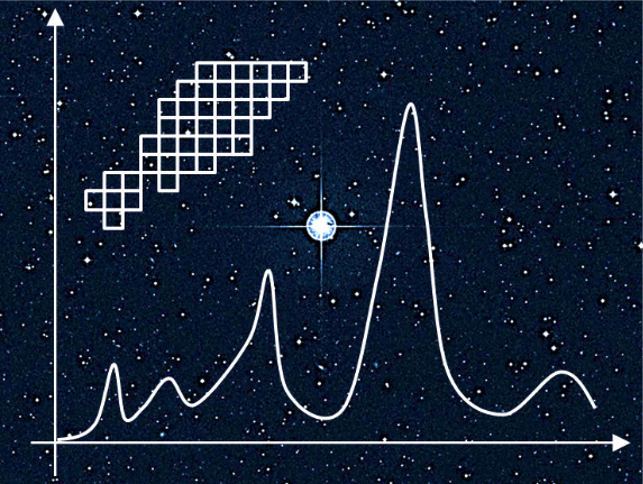
The CLAS experiment sheds light on the internal structure of protons
The CLAS experiment sheds light on the internal structure of protons
In an experiment performed with the CLAS detector at Jefferson Lab (USA), by using as a probe a beam of polarized electrons accelerated to intermediate energies (of the order of the proton mass), it was possible to measure some global properties of protons polarized in a strong magnetic field. The measurement allows to verify the effective theories derived from quantum chromodynamics (QCD), the theory that describes the fundamental strong force. This allows to improve the understanding of the internal structure and the global properties of the nucleons, that is of the protons and neutrons comprising atomic nuclei, describing the dynamics between their constituents (quarks), and the mediators of the strong force (gluons). The results of the experiment, with a decisive contribution by INFN and some of the spokespersons being Italian, have been published on Nature Physics. New measurements now under way with the new apparatus CLAS 12 (see photo), will complete the picture in the upcoming years, providing more details on the complex interactions among quarks and gluons and on the way they influence the spin of the nucleons.
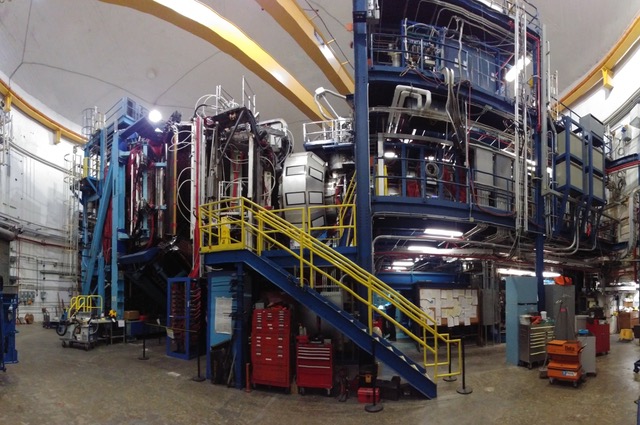
UNCOVERING THE MECHANISM OF ANGULAR MOMENTUM GENERATION IN NUCLEAR FISSION
Uncovering the mechanism of angular momentum generation in nuclear fission
The NU-BALL collaboration sheds light on an outstanding mystery of Nuclear Physics
Nuclear fission, in which a heavy nucleus splits in two and releases energy, was discovered at the end of the 1930s by the chemists Otto Hahn and Fritz Strassmann, and the physicists Lise Meitner and Otto Frisch. This physical phenomenon still has fascinating unknown aspects to be revealed. In the fission process, the fragments are observed to emerge spinning. This observation has been an outstanding mystery in Nuclear Physics for decades: the internal generation of around 6-7 units of angular momentum (or spin) in each fragment is particularly puzzling for systems which start with zero, or almost zero, spin.
A series of experiments at the Irène-Joliot-Curie Laboratory in Orsay, France, has now revealed, unexpectedly, that the fragments resulting from nuclear fission obtain their intrinsic angular momentum after fission and not before, contrary to what most theories have hypothesized thus far. This surprising result was made possible by the NU-BALL collaboration, an international group of nuclear physicists which has measured, with high precision, the gamma radiation emitted by the fast-neutron-induced fission of uranium 238U and thorium 232Th isotopes, in an experimental campaign that lasted 7 weeks.
These new insights into the role of angular momentum in nuclear fission are of fundamental important for a profound understanding of the fission process, with relevant consequences for other research areas, such as the study of the structure of neutron-rich isotopes, the synthesis and stability of super-heavy elements and, in applied fields, on the gamma-ray heating problem in nuclear reactors.
The results of NU-BALL have been published in Nature on 25/02/2021, https://doi.org/10.1038/s41586-021-03304-w
The NU-BALL collaboration has used a high-granularity gamma spectrometer made of more than 100 high-purity and large-volume Germanium detectors from the European GAMMAPOOL network (http://gammapool.lnl.infn.it). The collaboration includes researchers from 37 institutes and 16 countries – among them scientists from the University of Milan and the National Institute of Nuclear Physics (belonging to the GAMMA experiment from the Nuclear Physics Committee 3), who have actively contributed to the setting up of the detectors, to the data analysis and interpretation of the results, now published in Nature.
For further info:
Prof. Silvia Leoni, This email address is being protected from spambots. You need JavaScript enabled to view it.
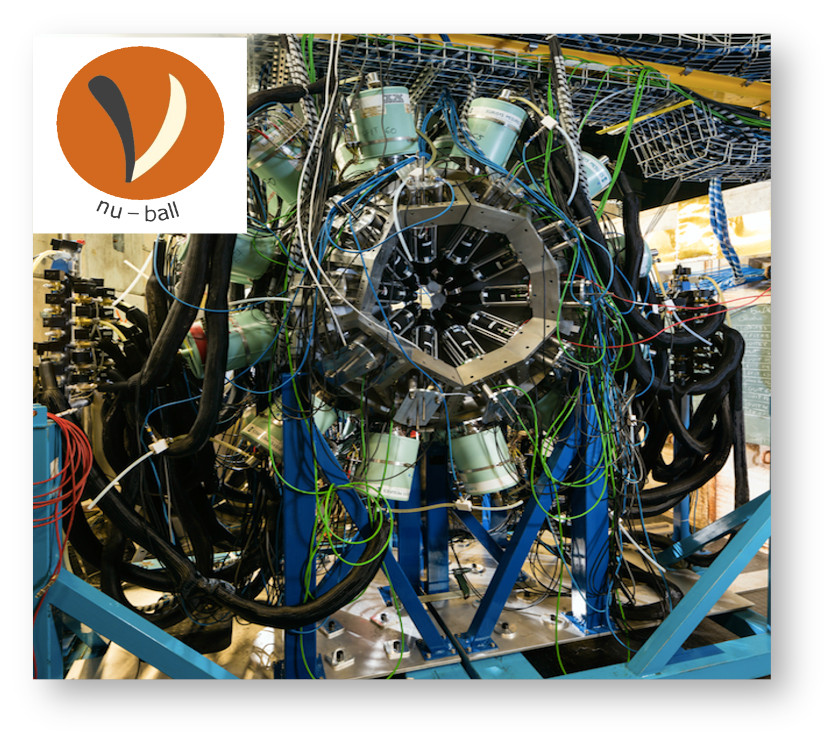
The installation of AGATA at the Legnaro National Laboratories is underway
The installation of AGATA at the Legnaro National Laboratories is underway
AGATA is a gamma ray spectrometer fruit of a European collaboration, made up of segmented hyper pure germanium crystals. It is the most sophisticated detector for gamma rays, completely innovative because it allows to trace the path of the single photon inside the germanium crystal with a resolution of a few millimeters. This allows to considerably increase the detection efficiency of the AGATA spectrometer and to identify with high precision the direction of the photon incident on the detector. The high positional accuracy is obtained thanks to the analysis of the shape of the electronic signals produced by gamma rays.
Thanks to these unprecedented characteristics, the AGATA detector is a real "eye" capable of looking inside the atomic nuclei produced in the collisions between accelerated ions, the type of experiments that will be carried out at the Legnaro National Laboratories (LNL) starting from 2022. With these measurements it will be possible to study in detail the properties of the excited states of atomic nuclei, thus helping us to understand the structure of the nucleus and the forces that bind protons and neutrons in it, making up the world around us. Not only that: the experiments with AGATA will also allow us to understand how the nucleosynthesis of elements occurs in stellar processes, such as mergers of neutron stars.
The arrival of AGATA at LNL therefore fits perfectly with the entry into operation at LNL, in the coming years, of the new SPES accelerator system that will allow us to study nuclear reactions using exotic, i.e. unstable, nuclear beams, thus getting closer and closer to what happens in the universe in the astronomical sites where the elements that make up our world are generated.
The Italian scientific community, represented by the staff of the National Institute of Nuclear Physics (INFN), is one of the pillars of this frontier European project for gamma spectroscopy and, not surprisingly, an important phase in the development and use of AGATA will take place in Italy in the next few years
